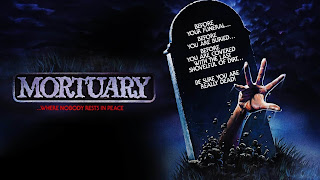(a.k.a.
STEPHEN KING’S GRAVEYARD SHIFT; director: Ralph S. Singleton.
Screenwriter: John Esposito, his script loosely based on Stephen King’s short
story of the same name, originally published in Cavalier magazine,
October 1970 issue, and later collected in King’s 1978 story anthology NIGHT SHIFT.)
Review
A drifter, John Hall (David Andrews, A NIGHTMARE ON ELM STREET, 1984), wanders into a Maine textile mill town, and is hired at the cemetery- and river-adjacent Bachman Mill by its sadistic manager, Warwick (Stephen Macht, THE MONSTER SQUAD, 1987). The mill, like the town, is a seething cesspool of economic desperation, interpersonal tension, amassing rats (there’s rat hair in the local diner’s food), chemical pollution, health code violations, fatal “accidents” and lechery─that last quality is especially embodied by Warwick, who’s slept with many of his female employees. Warwick dislikes polite “college boy” (Warwick’s words) Hall. His barely restrained animosity increases when Jane Wisconsky (Kelly Wolf), who regularly rebuffs the mill manager’s advances, engages in a flirtatious friendship with Hall.
Several violent, gory employee deaths─shown onscreen as extreme close-up monster attacks─happen during Hall’s first few days in town. July fourth quickly arrives. That means that the mill needs its decades-abandoned, and trash-filled basement cleaned to get ahead of expensive health code violations that might shut the mill down. Cleanup employees, supervised by Warwick, include Hall, Wisconsky, Carmichael (a newly hired African American employee), and several of Warwick’s cronies (Danson, Brogan, and Stevenson, who’ve been bullying the strong-but-restrained Hall).
Hall, during the shift, discovers the source of the swarming rats: an abandoned subbasement they’ve been driven from, leading to the question: what drove them from their cemetery-linked nest? Unfortunately for Warwick, Hall, and the others it’s a subbasement they must investigate.
This critically and audience underrated film is one of my favorite King-cinematic adaptations. GRAVEYARD is pervasive-dread atmospheric with its down and dirty execution, icky and dark visuals, and shadow-past characters (few are innocent here, except for Carmichael and Wisconsky).
GRAVEYARD spices its ugly, sharp tone with Vietnam War metaphors and set-ups, e.g., Tucker Cleveland (called “The Exterminator” by IMDb), a vermin killer for Marshall Extermination, is a vocal Vietnam veteran. Also, lots of closeup shots resemble war-film combat shots, especially in GRAVEYARD’s third act when Warwick’s alpha male actions further endanger those around him.
The monster, initially seen in extreme closeups (big shadow, claws, wings, jaws, etc.), is realistic enough to be believable while incorporating a 1950s Big Monster details in the visual mix. It, like many of the film’s other elements, maintains GRAVEYARD’s down and dirty vibe and overall thematic conceit. I can well imagine director/special effects artist Bert I. Gordon approving of it.
GRAVEYARD also has an underlying sense of humor, like the scene where one of the characters, Ippeston, sitting in a diner booth behind Hall and Wisconsky, reads a paperback copy of Gilbert A. Ralston’s 1972 movie tie-in novel, BEN, about a lonely boy and his pet rat.
This being a King-sourced film, there are references to some of his other works, e.g., Wisconsky’s mention of Castle Rock (the site of numerous King works), and Cleveland’s skewering of “cheap” mine boss (Bachman)─King briefly wrote under the nom de plume Richard Bachman.
The cast is excellent, though two actors steal the film: Stephen Macht, as mill manager Warwick, oozes alpha male malevolence and privilege, making him one of the best villains of any film released in 1990; Brad Dourif’s over-the-top Cleveland harbors a grim-humored hatred of rats and the Vietcong as well as a curious empathy, the latter evidenced by his love of his small, rat-terrorizing dog, Roxie.
Other notable, effective cast members include Andrew Divoff (WISHMASTER, 1997), as Danson, and Victor Polizos (C.H.U.D.,1984) as Brogan, Bachman Mill employees and bullies. Jonathan Emerson (THE UNBORN, 1991) has a brief role at the beginning of the film as Jason Reed, a cotton picker operator who should spend less time mocking rats.
GRAVEYARD isn’t perfect (few films are)─e.g., its editing occasionally feels choppy, especially in the beginning. But if you can overlook that, are not a King purist, are a fan of gory and gritty filmmaking (GRAVEYARD sports great set design, lighting, etc.), and like big, Old School Horror monsters, you might enjoy GRAVEYARD, a good expansion of King’s excellent story.
#
For those comparing the differences between the story and the film (minor film-story spoilers follow). If you don't want to know, read no further.
Tucker Cleveland/The Exterminator doesn’t exist in King’s story. He’s a film-only character.
In the story, Wisconsky is mentioned by Hall as Warwick’s boss. In the film, Hall’s love interest, Jane, has the surname Wisconsky, and the never-shown Bachman is Warwick’s boss.
The film is structured with a Vietnam War metaphor that the source story lacks.
John Hall and Warwick’s cinematic reactions to the discovery of the subbasement are reversed from the story. In the film, Warwick is gung-ho and murderous; Hall, in his right mind, is terrified and runs. In the story, Hall hates Warwick and kills him by impelling the sadistic mill manager toward a giant, mutated rat, described as the magna mater (queen mother).





